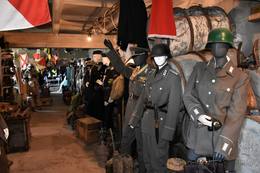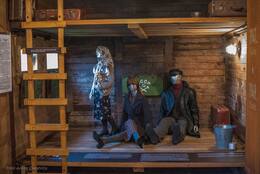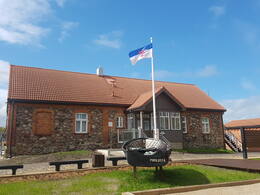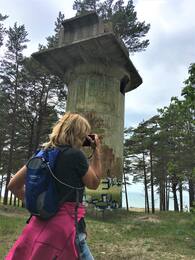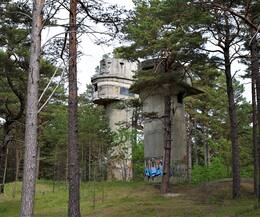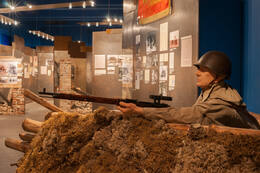Hitler - Stalin / Molotov - Ribbentrop Pact
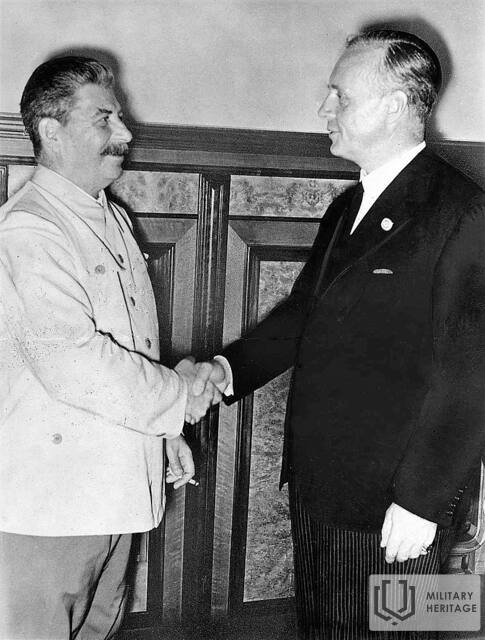
August 23 is declared European Day of Remembrance for the Victims of Stalinism and Nazism, with the signing of the Molotov-Ribbentrop Pact, which changed the worldview and history. On August 23, 1939, the Union of Soviet Socialist Republics (USSR, Soviet Union) and Germany signed the "Non-Aggression Pact," known as the Molotov-Ribbentrop Pact. At the same time as the Molotov-Ribbentrop Pact, a "Secret Additional Protocol" was signed, in which the parties agreed to share areas of mutual interest in Eastern Europe. Finland, Estonia, Latvia, part of Lithuania and Bessarabia had to come under the influence of the USSR, and the southern part of Lithuania - under the influence of Germany, which was later redistributed to the USSR.
The Secret Additional Protocol of 23 August states that Latvia and the other Baltic States will experience "cases of territorial political rearrangement". The understanding of these is clear from Stalin's words a few days before the signing of the protocol on 28 September: 'Germany gives us complete freedom of action in the Baltic States'. It should be noted that on September 28, 1939, the USSR concluded a Mutual Assistance Agreement with Estonia, and on October 5 and 10, 1939, with Latvia and Lithuania, respectively. Later, on October 25, 1939, Stalin, in a conversation with G. Dimitrov, Secretary General of the Executive Committee of the Comintern, stated: . Only for the time being, it is necessary to strictly respect their internal regime and sovereignty, without trying to achieve Sovietization. The time will come when they will do it themselves [VS]. ”
The time came on June 16, 1940, when the USSR issued an ultimatum to Latvia. Later, the territory of Latvia was occupied and annexed, but the population was subjected to brutal repression: mass murder, unjustified imprisonment and torture, deportation thousands of kilometers from their homeland, forced labor and forced to live in inhumane conditions. These events radically changed the history of Latvia and put Latvia's development on a difficult path.
The Congress of People's Deputies of the USSR, in its decision of 24 December 1989 "On the Political and Legal Assessment of the 1939 Non-Aggression Pact between the USSR and Germany", stated that the secret protocols concluded with Germany were legally unfounded and invalid from the moment they were signed. Germany reached similar conclusions in its declaration of 1 September 1989. Germany described the secret additional protocols as a shameful attack on international law. It stated that the protocols could not justify the violations of international law committed by Germany and the USSR. In its turn, in the Declaration of May 4, 1990 “On the Restoration of the Independence of the Republic of Latvia”, the Supreme Council of the Soviet Socialist Republic of Latvia declared the Molotov-Ribbentrop Pact illegal.
More information sources
Sajadova, V. Molotov-Ribbentrop Pact and Its Influence on the Sovereignty of the State of Latvia. Available: http://okupacijasmuzejs.lv/lv/latvijas-okupacijas-vesture/1-padomju-okupacija/molotovaribentropa-pakts-un-ta-ietekme-uz-latvijas-valsts-suverenitati [accessed 06.05.2021].
Related timeline
Related objects
Private military collection in Mundigciems
Private military collection in Mundigciems. Aivars Ormanis has been collecting historical objects for many years - military uniforms, uniforms, camouflage, communication devices, household items, protective equipment from different periods and countries, dating back to the Second World War, the Soviet army and the restoration of independent Latvia.
The collection is currently not well maintained and the exhibits are housed in a former collective farm barn.
Cattle wagon used for deportations – museum at Skrunda train station
To commemorate the deportations of June 1941 and March 1949, a memorial stone and a four-axle wagon, which also serves as the museum dedicated to deportations, was erected at the Skrunda railway station. This is the first wagon-type museum in Latvia that holds a permanent exhibit of photos, letters, memoirs, documents and various items made by the people deported from the Skrunda station. Skrunda station was a location where deportees were gathered, and one of the three stations in the region to which people from the Skrunda and the Kuldīga area were brought. In 1941, the family of the first President of the restored Republic of Latvia, Guntis Ulmanis, was deported from here to Krasnoyarsk Krai in Siberia.
With the help of deportations, the Soviets dealt with supporters of the national partizans’ and at the same time intimidated the remaining rural population, forcing them to join the collective farms.
Pāvilosta local history museum exposition
Named ‘Pāvilosta, a Closed Area’, the exhibit in the Pāvilosta Local History Museum is about everyday life in the town of Pāvilosta during the Soviet occupation; specifically, about the executive branch, border area, fishermen’s collective farm, and the cultural and social activities. In addition to the permanent exhibit, there is an interactive and emotionally rich digital exhibit in two languages and an audio-visual installation offering a film about Pāvilosta.
The museum also features a new exhibit named ‘The Golden Sand Grains of Pāvilosta’. The digital installation showcases old events, how Pāvilosta was founded and the most important developments from 1918 to the present day. Military heritage is a point of focus in the War of Independence section, which tells a story about the freedom fighters of Latvia and the time of the Soviet occupation.
Rangefinder No.1 of the 23rd Shore Battery (1941)
The rangefinders (dating from 1941) are located in the pines of the dune, only 10m from the other tower, built in 1954. The 1st and 2nd gun emplacements of the shore battery are located on the seafront and partially eroded, while the 4th gun emplacement is best seen in the dunes. The reinforced concrete bunker of the personnel who manned the guns is now washed away by the waves and has a washed-out foundation, tilted and leaning seawards.
Liepaja Fortress Battery 2 was planned to be built further from the shoreline and protected by a high rampart. The armament of the battery was to be 16 11-inch (280 mm) mortars of the 1877 model. The mortars used steep trajectories and did not require direct aiming.
Following the 'base agreement' between the Republic of Latvia and the USSR, signed on 5 October 1939, a contingent of nearly 25 000 Red Army and Baltic Navy troops was to be stationed in Kurzeme. By March 1941, Baltic naval bases were established in Latvia in the defence sectors of Irbe Bay, Saaremaa and Liepāja, consisting of coastal defence batteries.
The Liepaja coastal defence sector included the 208th artillery division with two 130 mm B-13 gun batteries (No 23 and No 27) and one 180 mm rail gun battery. Construction of Battery 23 began in November 1939 and was completed on 17 May 1941, partly using the reinforced concrete fortifications of Battery No. 2 of Liepaja Fortress. Battery 23 consisted of four reinforced concrete gun positions on the seafront, a command post and an observation (range-finding) tower in the dune forest. The range-finding positions were located in reinforced concrete towers to ensure better visibility while maintaining concealment in the pine forest.
After the Second World War, Battery 23 was renamed Battery 636, armed with the same 130 mm B-13 guns, and a new range-keeping tower was built for fire control in 1954, adjacent to the 1941 tower. In 1963, all the Liepaja coastal defence guns were dismantled.
After the restoration of Latvia's independence, the area of Battery No 2 is in the use of the Ministry of Defence.
Liepaja Coast Defence Battery 23
The battery is located between Tobago and Marine Streets, seawards.
According to the "base agreement" between the Republic of Latvia and the USSR, signed on 5 October 1939, a contingent of nearly 25 000 Red Army and Baltic Navy troops was to be stationed in Kurzeme. By March 1941, Baltic naval bases were established in Latvia in the defence sectors of Irbe Bay, Saaremaa and Liepaja, consisting of coastal defence batteries.
The Liepaja coastal defence sector included the 208th artillery division with two 130 mm B-13 gun batteries (No 23 and No 27) and one 180 mm rail gun battery. Construction of Battery 23 began in November 1939 and was completed on 17 May 1941, partly using the reinforced concrete fortifications of Battery No. 2 of Liepaja Fortress. Battery 23 consisted of four reinforced concrete gun positions on the seafront, a command post and an observation (range-finding) tower in the dune forest. The range-finding positions were located in reinforced concrete towers to ensure better visibility while maintaining concealment in the pine forest.
Gun positions 1 and 2 are located on the seafront and partially eroded, while gun position 4 is the most visible in the dunes. Battery 23 was blown up by Soviet soldiers on 27 June 1941 during the retreat from Liepāja.
After the Second World War, Battery 23 was renamed Battery 636, armed with the same 130 mm B-13 guns, but a new range-keeping tower was built in 1954 for fire control, adjacent to the 1941 tower. In 1963, all the Liepaja coastal defence guns were dismantled.
After the restoration of Latvia's independence, the area of Battery No 2 is in the use of the Ministry of Defence.
The two towers are located very close to each other - only 10 m apart. The four gun positions were located to the right of both towers, actually on the seafront. The reinforced concrete bunker of the personnel who manned the guns is now washed away by the waves and has a washed-out foundation, tilted and leaning seawards.
Latvian War Museum
The Latvian War Museum is located in the Old Town not far from the Freedom Monument in a historic defence building called the ‘Powder Tower’. There are 11 exhibits in the museum. There are various weapons, documents, uniforms, awards, badges and other items detailing the everyday life of a soldier in war. The Latvian War Museum is one of the oldest museums in Latvia. Its origins can be found in World War I. Museum’s collection was made up mainly of personal items of soldiers or items found on battlefields. After Latvia gained its independence the main goal of the museum became to create an exposition on the military history of Latvia and the active role of the population in protecting their land. In 1937 the museum was expanded and was technically one of the most modern museums in Europe at that time. The Powder Tower was one of the fortification towers of Riga. Some evidence dates back to 1330 where it has been mentioned as the ‘Sand Tower’. The tower was destroyed in 1621 when Riga was besieged by the Swedish Army. But in 1650 a new tower for storing gunpowder and weapons was built. After the city’s fortifications were taken down, the Powder Tower remains as one of the most important pieces of evidence of the Riga defence system.
Related stories
On the occupation of Latvia
The existence of the independent state of Latvia in 1940 was interrupted by the occupation and annexation by the Soviet Union, or incorporation into the Union of Soviet Socialist Republics (USSR).
Missing soldiers of the German army during the Great Battle of Kurzeme
The records of the German army group "North", later renamed "Kurland" during the siege of Courland, still do not contain clear information about the approximately 50 000 German soldiers. These soldiers are listed as missing. Even today, the relatives of these soldiers are trying to find traces of their relatives and ancestors in Kurland, both documentary and physical. One such story is that of Karl Grimm, a German soldier from Swabia (a historical region in south-west Germany, at the source of the Rhine and Danube rivers), whose war career was cut short on 27 October 1944 at the Krūmi home near Vaiņode (5 km to the NW from Vaiņode, Latvia)




